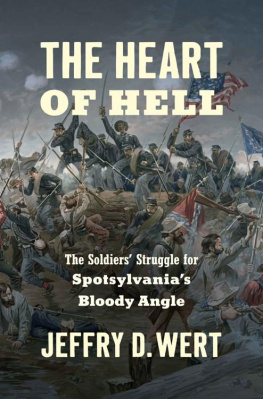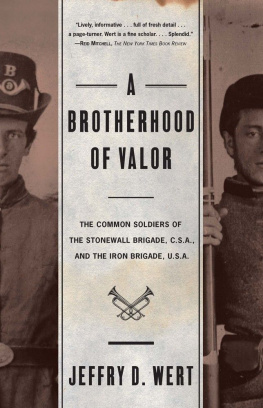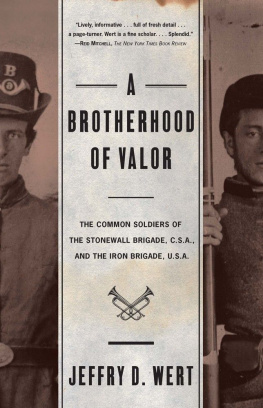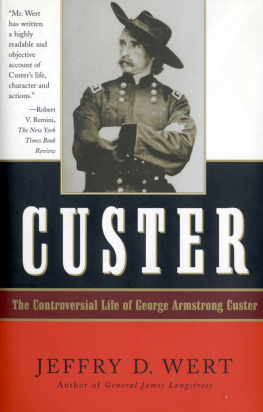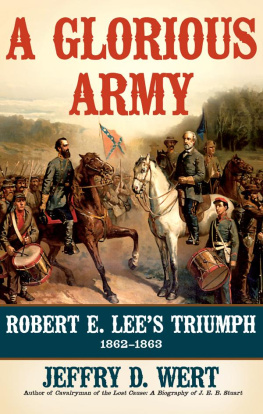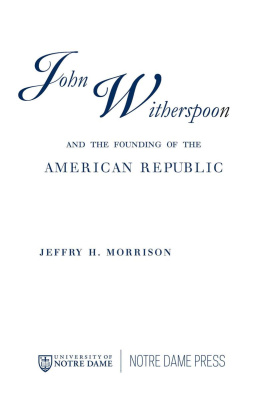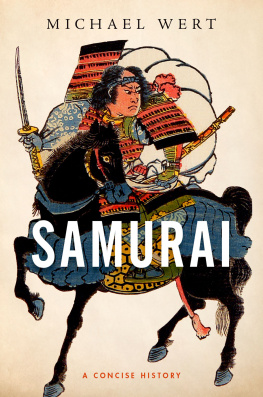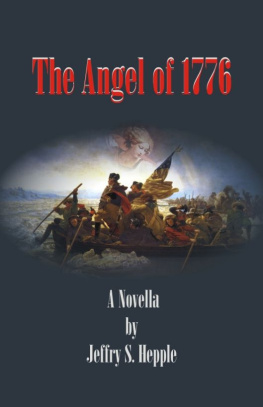Jeffry D. Wert - The Heart of Hell (Civil War America)
Here you can read online Jeffry D. Wert - The Heart of Hell (Civil War America) full text of the book (entire story) in english for free. Download pdf and epub, get meaning, cover and reviews about this ebook. year: 2022, publisher: The University of North Carolina Press, genre: Science. Description of the work, (preface) as well as reviews are available. Best literature library LitArk.com created for fans of good reading and offers a wide selection of genres:
Romance novel
Science fiction
Adventure
Detective
Science
History
Home and family
Prose
Art
Politics
Computer
Non-fiction
Religion
Business
Children
Humor
Choose a favorite category and find really read worthwhile books. Enjoy immersion in the world of imagination, feel the emotions of the characters or learn something new for yourself, make an fascinating discovery.
- Book:The Heart of Hell (Civil War America)
- Author:
- Publisher:The University of North Carolina Press
- Genre:
- Year:2022
- Rating:4 / 5
- Favourites:Add to favourites
- Your mark:
- 80
- 1
- 2
- 3
- 4
- 5
The Heart of Hell (Civil War America): summary, description and annotation
We offer to read an annotation, description, summary or preface (depends on what the author of the book "The Heart of Hell (Civil War America)" wrote himself). If you haven't found the necessary information about the book — write in the comments, we will try to find it.
The Heart of Hell (Civil War America) — read online for free the complete book (whole text) full work
Below is the text of the book, divided by pages. System saving the place of the last page read, allows you to conveniently read the book "The Heart of Hell (Civil War America)" online for free, without having to search again every time where you left off. Put a bookmark, and you can go to the page where you finished reading at any time.
Font size:
Interval:
Bookmark:
The Heart of Hell
Civil War America
PETER S. CARMICHAEL, CAROLINE E. JANNEY, and AARON SHEEHAN-DEAN, editors
This landmark series interprets broadly the history and culture of the Civil War era through the long nineteenth century and beyond. Drawing on diverse approaches and methods, the series publishes historical works that explore all aspects of the war, biographies of leading commanders, and tactical and campaign studies, along with select editions of primary sources. Together, these books shed new light on an era that remains central to our understanding of American and world history.
The Heart of Hell
THE SOLDIERS STRUGGLE FOR SPOTSYLVANIAS BLOODY ANGLE
Jeffry D. Wert

THE UNIVERSITY OF NORTH CAROLINA PRESS CHAPEL HILL
2022 Jeffry D. Wert
All rights reserved
Set in Miller and Stymie by Westchester Publishing Services
Manufactured in the United States of America
The University of North Carolina Press has been a member of the Green Press Initiative since 2003.
Library of Congress Cataloging-in-Publication Data
Names: Wert, Jeffry D., author.
Title: The heart of hell : the soldiers struggle for Spotsylvanias Bloody Angle / Jeffry D. Wert.
Other titles: Civil War America (Series)
Description: Chapel Hill : University of North Carolina Press, [2022] | Series: Civil War America | Includes bibliographical references and index.
Identifiers: LCCN 2021054796 | ISBN 9781469668420 (cloth) | ISBN 9781469668437 (ebook)
Subjects: LCSH : Spotsylvania Court House, Battle of, Va., 1864.
Classification: LCC E 476.52 . W 45 2022 | DDC 973.7/36dc23/eng/20211116
LC record available at https://lccn.loc.gov/2021054796
Jacket illustrations: Front , Thure de Thulstrup, Battle of Spottsylvania [sic] (Boston: L. Sprang & Co., 1887); back , Alfred R. Waud, The Toughest Fight Yet (May 12, 1864). Both courtesy of the Library of Congress Prints and Photographs Division.
To Gloria, Jason, Kathy, Rachel, Gabriel, Natalie, and Grant with love.
Contents
Maps
Preface
At 4:35 A.M. on Thursday, May 12, 1864, twenty thousand officers and men of the Second Corps, Union Army of the Potomac stepped forth. Ordered by General-in-Chief Ulysses S. Grant to lead a major offensive, these veteran troops advanced toward a bulge (often referred to as a salient) in Confederate defenses outside of Spotsylvania Court House, Virginia. Ahead of them, their foes in the Army of Northern Virginia maintained a tenuous position behind earthworks.
Battle-tested as both armies were, neither side could anticipate the hellish ordeal that would unfold over the next day. But for weeks they had speculated around campfires about when once again they would meet their old foes on battlefields. In this, the conflicts fourth spring, the wars end seemed as elusive as it had in the previous three. Although Union forces had won critical victories at Gettysburg, Pennsylvania, and at Vicksburg, Mississippi, in the summer of 1863, two major Confederate armies remained in the field, standing defiantly in Virginia and in Georgia. As the officers and men anticipated, active campaigning resumed with warm weather and the drying of roads during the first week of May. Union offensives went forward against both Confederate forces, with coordinated movements that had been planned and ordered by Grant, appointed commander of federal forces with the rank of lieutenant general two months earlier.
In Georgia, Major General William T. Sherman led three armies south toward Atlanta, against General Joseph E. Johnstons Army of Tennessee. In Virginia, meanwhile, the offensive consisted of a three-prong advanceone, south up the Shenandoah Valley toward rail connections; a second on Bermuda Hundred between the James and Appomattox rivers toward the Confederate capital of Richmond; and the main operation in central Virginia against General Robert E. Lees redoubtable Confederate host. Each of these offensives, each forthcoming engagement, each advance or retreat unfolded against the backdrop of the falls presidential election in the North.
Grant accompanied Major General George G. Meades Army of the Potomac in its confrontation with Lees Army of Northern Virginia, pitting the conflicts greatest generals against one another. In their letters and diaries during the early spring, soldiers in both armies awaited the historic meeting between the pair, arguing who would be the victor. Both commanders, however, faced difficulties. Within days of the campaigns outset, Grant witnessed firsthand the armys leadership, which was plagued by cautiousness characterized by a deeply held attitude of avoiding defeat instead of attaining victory. This attitude had been the armys history and its curse, ingrained seemingly into the armys soul by its second commander, George B. McClellan. Grant soon determined that he would have to direct the operations personally if he was to exorcise McClellans ghost.
For Lee, the difficulties were far graver. His battle-tested veteransarguably the wars finestwould have to wage a struggle against a force nearly twice its size. The armys combat prowess suffered from a depleted officer ranks, particularly at the rank of major, lieutenant colonel, and colonel. Furthermore, Lee had mounting concerns with the capabilities of corps commanders Richard Ewell and A. P. Hill. Lee understood also that his army would likely be waging a defensive struggle in the impending campaign, whose direction rested with his opponent.
It took time for Grant and Lee to take the measure of each other. The long-awaited encounter began in the so-called Overland Campaign on May 4, when the Federals crossed the Rapidan River, moving south and east. It had been exactly ten months since the Rebels had begun a retreat after their defeat by the Yankees at Gettysburg. Since then, these foes had met in a pair of indecisive operationsthe Bristoe Campaign in October 1863 and the Mine Run Campaign in November. The first major clash came on May 5, in a blinding struggle in the Wilderness of Spotsylvania. On this day and the next, the opponents fought each other in a series of attacks and counterattacks. By nightfall on May 6, the armies remained on the battlefield. Unlike in the past, the Federals went forward, not back, the next day. To Grant, there was to be no retreating, and he directed the army toward Spotsylvania Court House on the roads to Richmond. There, on a rainy Thursday, began a dark future: land scarred by entrenchments, doomed assaults, and daily bloodletting that those in the ranks endured in an unending nightmare from North Anna to Cold Harbor to the many battlefields of Petersburg.
The armies remained outside of the crossroads village of Spotsylvania from May 8 until May 20. By the time they departed, the nature of warfare in the Overland and future campaigns had been altered. Both armies had erected fieldworks in the Wilderness; in fact, the first extensive use of such works in Virginia had been by Lees troops during the Mine Run Campaign. At Spotsylvania, however, the entrenchments of logs and dirt extended for miles. Behind them Confederate defenders repulsed enemy frontal assaults on May 8 and 10. Attacking in linear formations, Grants Union troops staggered and recoiled before the rifle and cannon fire from behind the man-made defenses.
A breakthrough occurred on the evening of May 10, when a dozen Union regiments, led by Colonel Emory Upton and stacked three regiments across in four lines, penetrated a section of the salient at the northern limit of Confederate lines. When reinforcements failed to appear, Confederate reserves drove back Uptons troops. But Uptons tactical use of a deep column and its limited success convinced Grant to undertake a larger and similarly arrayed attack on the salient, which its defenders had dubbed the Mule Shoe. So, in the morning darkness, fog, and rain of May 12, veteran infantrymen of the Second Corps charged.
Next pageFont size:
Interval:
Bookmark:
Similar books «The Heart of Hell (Civil War America)»
Look at similar books to The Heart of Hell (Civil War America). We have selected literature similar in name and meaning in the hope of providing readers with more options to find new, interesting, not yet read works.
Discussion, reviews of the book The Heart of Hell (Civil War America) and just readers' own opinions. Leave your comments, write what you think about the work, its meaning or the main characters. Specify what exactly you liked and what you didn't like, and why you think so.

